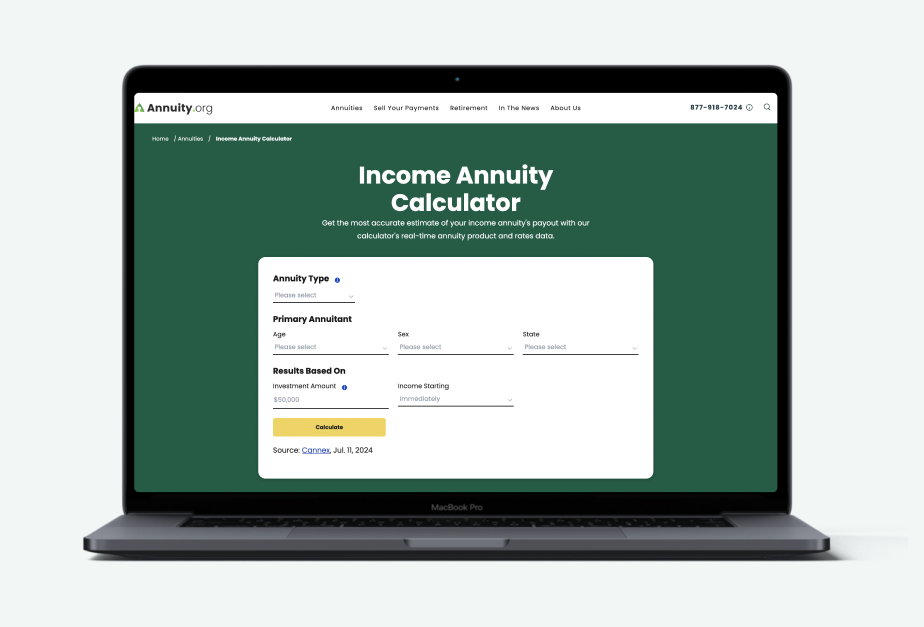The charts below illustrate estimated monthly payouts and annual payout percentages for lifetime income annuities, broken down by age and payout type, to give you a clear picture of how much income a $50,000 annuity can provide.
Your actual income will vary based on factors such as your age, gender, and whether you select a single-life or joint-life option. Still, these examples offer a helpful, realistic benchmark for what you might receive.
Monthly Payouts for $50,000 Immediate Life Annuity
| Age | Male | Female | Joint Life |
| 60 | $299 | $290 | $267 |
| 65 | $325 | $313 | $284 |
| 70 | $366 | $347 | $309 |
| 75 | $429 | $399 | $345 |
| 80 | $526 | $483 | $402 |
This chart illustrates the estimated monthly income from a $50,000 immediate annuity, based on your age and chosen payout type. The examples assume payments start right away and continue for life, with calculations shown for male, female, and joint-life annuitants.
With a single life option, payments last for as long as the annuitant lives. The joint life option provides income until both spouses (of the same age) have passed.
Because payments are spread over your expected lifetime, older buyers receive larger monthly amounts, while younger buyers receive smaller ones that last longer. Men generally receive slightly higher payouts than women, reflecting shorter average life expectancy, and joint annuities typically have lower monthly payments to account for the possibility of paying over two lifetimes.
Annual Percentage* Payouts for $50,000 Immediate Lifetime Annuity
| Age | Male | Female | Joint Life |
| 60 | 7.18% | 6.96% | 6.41% |
| 65 | 7.80% | 7.51% | 6.82% |
| 70 | 8.78% | 8.33% | 7.42% |
| 75 | 10.30% | 9.58% | 8.28% |
| 80 | 12.62% | 11.59% | 9.65% |
This chart shows the annual payout rates for a $50,000 guaranteed lifetime annuity, based on your age and whether you choose a single-life or joint-life option.
A payout rate is not an interest rate, it represents the total annual income you receive as a percentage of your original investment, combining both interest and a return of principal. For example, a 75-year-old male with a $50,000 annuity would receive about 10.30% annually, or roughly $429 per month.
Older buyers generally qualify for higher payout percentages because payments are expected to last for fewer years. Joint life annuities pay less because they continue as long as either spouse (of the same age) is alive, which extends the expected payment period.
This metric is a valuable way to compare income options and assess the long-term value of guaranteed payments you can’t outlive.
What a $50,000 Annuity Looks Like in Practice
To see how different factors can affect the income from a $50,000 annuity, we’ve created three hypothetical examples. Each scenario features a different customer profile, showing how age, gender, and payout type influence the amount of guaranteed income you could receive from the same investment.
These estimates are based on data from Cannex and online annuity calculators, and are designed to give you a realistic sense of how payouts might look in real life — not exact quotes.
Meet Chris — Planning for a Steady Retirement Income Stream

Name: Chris
Age: 65
Looking to Invest: $50,000
- Chris wants a guaranteed income stream for life
- He purchases an immediate annuity with a lifetime payment
Monthly Payout: $325
Chris has recently retired and is looking to add another source of predictable income to supplement his Social Security and other retirement savings. While he’s already receiving benefits, Chris wants to ensure he has enough to comfortably cover his expenses every month without worrying about market ups and downs.
To achieve this, Chris invests $50,000 into an immediate annuity. This converts his savings into monthly payments of $325, starting shortly after his contract is issued.
Why He Chose a Lifetime Income Annuity
Chris selects a single-life policy, which continues payments until his death. The policy has no death benefit, meaning if Chris passes away before receiving the full value of his annuity premium, his beneficiaries will not receive the remaining balance. For Chris, maximizing his monthly payout while he’s alive is more important than leaving a financial legacy.
Knowing that his income is guaranteed for life gives Chris the peace of mind to enjoy retirement without the fear of running out of money.
Why This Works for Chris:
- The payout doesn’t fluctuate with the stock market.
- He knows the income will continue for life — no matter how long he lives.
- It supplements his Social Security benefits and other retirement income.
- It allows him to budget confidently, knowing his essentials will always be covered.
I like the idea of having another steady check every month. It takes the stress out of wondering if my savings will last. – Chris
Bottom Line: Chris’s estimated monthly income from the annuity is $325, guaranteed for life. While the contract won’t pass value to his heirs if he dies early, the security of reliable monthly income is worth it for his retirement peace of mind.
Meet Eva — Planning for a Lifetime of Guaranteed Income

Name: Eva
Age: 60
Looking to Invest: $50,000
- Eva wants a guaranteed income stream for life
- She purchases an immediate annuity with a lifetime payment
Monthly Payout: $290
Eva is preparing to retire and wants the peace of mind that comes from knowing she’ll receive guaranteed income for the rest of her life. To achieve this, she invests $50,000 into an immediate lifetime annuity, which begins paying her $290 per month — starting shortly after the contract is issued.
Her payout is lower than Chris’s, even though they invested the same amount, for two main reasons: she is starting payments at age 60 (younger retirees receive smaller monthly payments because the payments are expected to last longer), and she is female (women typically receive slightly lower payments than men because they tend to live longer).
Why She Chose a Lifetime Income Annuity
Eva selects the single-life option, which provides income for as long as she lives but stops when she passes away. This means there is no death benefit — if she dies before receiving the full value of her premium, her beneficiaries will not receive the remaining amount.
For Eva, the priority is maximizing steady income during her lifetime so she can confidently cover her living expenses without worrying about market swings or outliving her savings.
Why This Works for Eva:
- The payout doesn’t fluctuate with the stock market.
- She knows the income will last for life — no matter how long she lives.
- It supplements her Social Security and helps cover her monthly expenses.
- It allows her to enjoy retirement without second-guessing every purchase.
I wanted to start my retirement knowing I’d have a reliable monthly income I can count on for the rest of my life. – Eva
Bottom Line: Eva’s estimated monthly income from the annuity is $290 — guaranteed for life. While it won’t pass to heirs, the security of knowing her essential expenses will always be covered makes this the right choice for her retirement plan.
Typically, with income annuities, retirees will put more than $50,000 into an annuity. However, if you are looking to supplement your income or cover a smaller monthly recurring bill, then a $50,000 annuity may be a good option. When people are looking to retire, they will reach out to me, and we will go through an income needs analysis, including inflation, to determine exactly how much funding is needed for the required income.
Meet Steve — Growing His Retirement Savings Before Taking Income

Name: Steve
Age: 62
Looking to Invest: $50,000
- Steve wants to grow his savings before turning them into income
- He purchases a 3-year fixed annuity with a 6% interest rate
Monthly Payout: $312
Steve’s situation is different from Frank, Chris, and Eva because he isn’t ready to start receiving annuity payments yet. With a few years left before retirement, Steve wants to grow his savings first. He invests $50,000 in a multi-year guaranteed annuity (MYGA) that earns a fixed 6% interest rate for the length of the 3-year contract.
When the MYGA matures, Steve plans to convert the balance into lifetime income. By that time, his initial investment will have grown to $59,551, giving him a higher monthly payout than if he had purchased an immediate annuity today. Assuming payout rates remain the same, this could mean around $374 per month once he starts receiving income.
Why He Chose a Multi-Year Guaranteed Annuity
Steve chose a MYGA because it allows him to lock in a competitive interest rate and grow his money without market risk. Since he doesn’t need income right away, this strategy helps him maximize future payments when he does transition to retirement.
Once the contract ends, he can choose to convert the accumulated value into lifetime payments, ensuring predictable income later while benefiting from the growth in the meantime.
Why This Works for Steve:
- He earns a guaranteed 6% interest rate without stock market risk.
- His savings will grow before converting to income, resulting in a higher payout.
- He can time his annuity start date to match his retirement plans.
- He locks in a predictable growth rate for three years.
“I’m not retiring just yet, so I’d rather grow my savings now and lock in a higher income when I’m ready.”
Bottom Line: Steve’s $50,000 investment will grow to $59,551 over three years at a 6% interest rate. When converted to income, his monthly payout will be higher than if he had started payments immediately, making this a smart choice for someone still a few years away from retirement.
Today’s Best Fixed Annuity Rates by Term
| Term | Rate | Provider | Product | AM Best Rating |
|---|---|---|---|---|
| 1 Year | 6.00% | Global Atlantic | ForeCare Fixed Annuity (LTC) | A |
| 2 Years | 5.50% | Axonic Insurance Services | Skyline MYGA | A- |
| 3 Years | 6.00% | Mountain Life Insurance Company | Alpine Horizon | B+ |
| 4 Years | 6.05% | Mountain Life Insurance Company | Alpine Horizon | B+ |
| 5 Years | 6.45% | Atlantic Coast Life | Safe Harbor Bonus Guarantee | B+ |
| 6 Years | 6.67% | Atlantic Coast Life | Safe Harbor Bonus Guarantee | B+ |
| 7 Years | 6.90% | Atlantic Coast Life | Safe Harbor Bonus Guarantee | B+ |
| 8 Years | 6.00% | Mountain Life Insurance Company | Secure Summit | B+ |
| 9 Years | 5.40% | Mountain Life Insurance Company | Secure Summit | B+ |
| 10 Years | 7.65% | Atlantic Coast Life | Safe Harbor Bonus Guarantee | B+ |

See How Much You Could Earn With Today’s Best Rates
Factors Impacting How Much a $50,000 Annuity Pays Per Month
Annuity providers calculate payouts differently for every annuity contract. An annuity with a $50,000 premium can have widely varying monthly payments depending on several factors.
- Annuitant’s age: Insurers use the annuitant’s life expectancy to calculate annuity payouts. The longer you’re expected to live, the more payments the insurer expects to pay out, so your payments will be shorter.
- Annuitant’s gender: Women tend to live longer than men, so a 75-year-old woman will receive slightly smaller annuity payments than a 75-year-old man.
- Type of annuity: The type of annuity can impact the annuity’s value at annuitization, which is used to calculate the payout amount. A $50,000 deferred annuity that earns interest will produce higher payouts than a $50,000 immediate annuity that starts paying out right away.
- Payout period: As previously stated, the longer you’re expected to receive payments, the smaller the payment amount will be. A 10-year period certain annuity will likely have a higher payout than a lifetime annuity. A $50,000 joint and survivor annuity that covers two lifetimes will have a lower payout than a single life annuity of the same amount.
- Riders: You can customize your annuity with riders and provisions, but these may affect your payout amount. For example, a return of premium rider or death benefit represents a greater level of risk to the insurer, so your payout amount will likely be slightly lower each month if you opt for these features.






